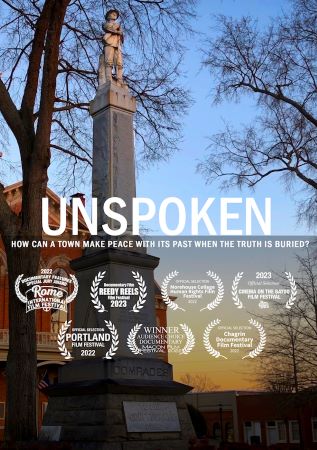
Unspoken 2022
Distributed by The Video Project, 145 - 9th St., Suite 230, San Francisco, CA 94103; 800-475-2638
Produced by Stephanie Calabrese
Directed by Stephanie Calabrese
Streaming, 78 mins
High School - General Adult
African American History; Race Relations
Date Entered: 01/16/2024
Reviewed by Michael A. LaMagna, Associate Professor & Reference Librarian, Delaware County Community College, Media, PATracing the history of the small town of Monroe, Georgia, Unspoken, works to ensure as Winston Churchill stated, “Those that fail to learn from history are doomed to repeat it.” This small, Southern town was the location of the last mass lynching in the United States which occurred in 1946. The Moore’s Ford Lynching occurred on July 25, 1946, when a white mob lynched two African-American couples in Walton County Georgia. Mae and George Dorsey and Dorothy and Roger Malcolm. It is worth noting the George Dorsey was a World War II veteran who had served in the Pacific theater and was back home in Georgia for less than a year. Roger Malcolm was accused of stabbing a white resident and was just released on bail when the lynching occurred. When police arrived at the crime scene, there were over 35 men, women, and children there witnessing the aftermath. This lynching was first picked up by African-American newspapers and shortly after by mainstream press. The focus on this event led to President Harry Truman sending the Federal Bureau of Investigation (FBI) investigating this case. No one was indicted as a result of this investigation.
This film not only provides an excellent introduction to this event but moves beyond the pure facts to examine how a small town in Georgia is coming to terms with its history, one that is not being taught in its schools, but how it is moving forward as a community. Filmmaker Stephanie Calabrese narration of historical facts weaves the story of this town together nicely with the interviews from local residents, historians, and journalists along with historical photographs. As the town learns about its own history, Calbrese does an excellent job of documenting how this community is working towards reconciliation through the yearly reenactment of this tragic event, but through preserving the cemetery where the victims of this lynching were buried which has fallen into disrepair over the years. Part of this reconciliation is shown through how the town addresses current debates around the Confederate flag and a Confederate monument in the town.
As the United States continues to grapple with its racial history, this film offers a guide on how a community can move forward collectively in remembering the past while ensuring for a more inclusive future. This film is recommended for any public or academic library collection and should be viewed by local historical societies to better understand how bringing this history to light can have a positive impact on the community at large. It is worth noting that when using this film in a classroom or with a group, those in the audience should be made aware that some of the content and imagery may be difficult to view.
Awards:Reedy Reels Film Festival, Best Documentary; Rome International Film Festival, Documentary Features, Special Jury Award; Macon Film Festival, Documentary Feature Audience Choice Award
Published and licensed under the Creative Commons Attribution 4.0 license. Anyone can use these reviews, so long as they comply with the terms of the license.